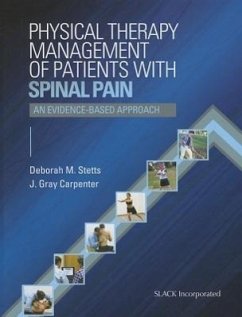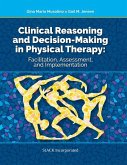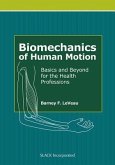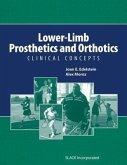Deborah Stetts, Gray Carpenter
Physical Therapy Management of Patients with Spinal Pain with Access Code
An Evidence-Based Approach
Deborah Stetts, Gray Carpenter
Physical Therapy Management of Patients with Spinal Pain with Access Code
An Evidence-Based Approach
- Gebundenes Buch
- Merkliste
- Auf die Merkliste
- Bewerten Bewerten
- Teilen
- Produkt teilen
- Produkterinnerung
- Produkterinnerung
In this rapidly changing health care environment, a challenge today's physical therapist faces is finding, evaluating, and implementing current best evidence into practice, an integral part of health care professional educational programs. With that goal in mind, Physical Therapy Management of Patients With Spinal Pain provides a comprehensive research-based overview of the examination and physical therapy interventions of the spine.
Andere Kunden interessierten sich auch für
![Cardiopulmonary Physical Therapy with Access Code Cardiopulmonary Physical Therapy with Access Code]() W Darlene ReidCardiopulmonary Physical Therapy with Access Code115,99 €
W Darlene ReidCardiopulmonary Physical Therapy with Access Code115,99 €![Clinical Reasoning and Decision Making in Physical Therapy Clinical Reasoning and Decision Making in Physical Therapy]() Gina MusolinoClinical Reasoning and Decision Making in Physical Therapy107,99 €
Gina MusolinoClinical Reasoning and Decision Making in Physical Therapy107,99 €![Biomechanics of Human Motion Biomechanics of Human Motion]() Barney LeveauBiomechanics of Human Motion88,99 €
Barney LeveauBiomechanics of Human Motion88,99 €![Integrative Therapies in Rehabilitation Integrative Therapies in Rehabilitation]() Carol M DavisIntegrative Therapies in Rehabilitation110,99 €
Carol M DavisIntegrative Therapies in Rehabilitation110,99 €![Occupational and Physical Therapy in Educational Environments Occupational and Physical Therapy in Educational Environments]() Irene McewenOccupational and Physical Therapy in Educational Environments154,99 €
Irene McewenOccupational and Physical Therapy in Educational Environments154,99 €![Family-Centred Assessment and Intervention in Pediatric Rehabilitation Family-Centred Assessment and Intervention in Pediatric Rehabilitation]() Mary LawFamily-Centred Assessment and Intervention in Pediatric Rehabilitation153,99 €
Mary LawFamily-Centred Assessment and Intervention in Pediatric Rehabilitation153,99 €![Lower-Limb Prosthetics and Orthotics Lower-Limb Prosthetics and Orthotics]() Joan EdelsteinLower-Limb Prosthetics and Orthotics103,99 €
Joan EdelsteinLower-Limb Prosthetics and Orthotics103,99 €-
-
-
In this rapidly changing health care environment, a challenge today's physical therapist faces is finding, evaluating, and implementing current best evidence into practice, an integral part of health care professional educational programs. With that goal in mind, Physical Therapy Management of Patients With Spinal Pain provides a comprehensive research-based overview of the examination and physical therapy interventions of the spine.
Hinweis: Dieser Artikel kann nur an eine deutsche Lieferadresse ausgeliefert werden.
Hinweis: Dieser Artikel kann nur an eine deutsche Lieferadresse ausgeliefert werden.
Produktdetails
- Produktdetails
- Verlag: Taylor & Francis
- Seitenzahl: 650
- Erscheinungstermin: 15. November 2013
- Englisch
- Abmessung: 282mm x 224mm x 30mm
- Gewicht: 2313g
- ISBN-13: 9781556429323
- ISBN-10: 1556429320
- Artikelnr.: 34377249
- Herstellerkennzeichnung
- Libri GmbH
- Europaallee 1
- 36244 Bad Hersfeld
- gpsr@libri.de
- Verlag: Taylor & Francis
- Seitenzahl: 650
- Erscheinungstermin: 15. November 2013
- Englisch
- Abmessung: 282mm x 224mm x 30mm
- Gewicht: 2313g
- ISBN-13: 9781556429323
- ISBN-10: 1556429320
- Artikelnr.: 34377249
- Herstellerkennzeichnung
- Libri GmbH
- Europaallee 1
- 36244 Bad Hersfeld
- gpsr@libri.de
Deborah M. Stetts, PT, DPT is an associate professor in the Department of Physical Therapy at Elon University, NC, where she teaches professional students in the area of musculoskeletal management. Current research interests involve the use of real-time ultrasound imaging to examine abdominal muscle performance in select patient populations. Dr. Stetts is board certified in orthopedic physical therapy and a Fellow of the American Academy of Orthopedic and Manual Physical Therapists. She has over 23 years of service as a physical therapist in the United States Army working in a variety of clinical, academic, and administrative positions. Dr. Stetts completed her DPT from Arizona School of Health Sciences, A.T. Still University, Mesa, AZ, in 2003; a master of physical therapy from the U.S. Army-Baylor University Graduate Program in Waco, TX in 1981; and a bachelor of science in health and physical education from Pennsylvania State University, State College, PA in 1976. She completed a residency in advanced orthopedic manual therapy at the Kaiser Physical Therapy Program, Hayward, CA, in 1990. Her professional experience and training have been primarily in orthopedic and manual physical therapy. J. Gray Carpenter, PT, DPT, COMT graduated with a bachelor's degree in physical therapy from East Carolina University, Greenville, NC in 1992 and completed his doctor of physical therapy from the University of North Carolina at Chapel Hill in 2006. Dr. Carpenter also completed the Certificate in Orthopedic Manual Therapy from Manual Concepts, Curtin University, Perth, Western Australia, in 2002. He became a board-certified specialist in orthopedics through the American Physical Therapy Association in 2008 and became a Fellow of the American Academy of Orthopedic and Manual Physical Therapists in 2009. During his career, Dr. Carpenter has primarily worked in outpatient orthopedic settings but has experience in several settings such as acute care, home health, inpatient rehab, and wound care. He currently works as a staff physical therapist at Alamance Regional Medical Center in Burlington, NC as well as serving as associate faculty at Elon University in the musculoskeletal module. Dr. Carpenter has been very active in the North Carolina Physical Therapy Association (NCPTA) and has held several positions with the NCPTA.
Dedication Acknowledgments About the Authors Preface Foreword by Mary C.
(Mary Kay) Hannah, PT, DPT Chapter 1Evidence-Based Practice in Physical
Therapy The Practice of Evidence-Based Physical Therapy Critical Appraisal
of Literature Related to Diagnostic Tests A Case Study in Diagnosis Using
the Critical Appraisal Criteria Critical Appraisal of Literature Related to
Intervention or Prevention Effect Size and Confidence Intervals A Case
Study in Intervention Using the Critical Appraisal Criteria Critical
Appraisal of Literature Related to Outcomes and Prognosis Chapter
2Subjective Examination: A Patient's History Communication During the
Patient Interview Goals of the Subjective Examination Content Areas of the
Patient History Pre-Examination Questionnaires Patient Demographic Profile
Chief Complaint (In Your Own Words, Please Tell Me What Your Main Problem
Is) Completing the Body Chart or Symptom Diagram Description and Assessment
of Pain and Other Symptoms History (Present or Current Episode) History
(Previous Episode[s] of Similar Problem) Symptom Behavior Review of Medical
Screening Questionnaire Patient Expectations and Goals Interview Summary
Planning the Physical Examination Chapter 3Components of the Basic
Neuromusculoskeletal Examination: Tests and Measures Goals of the Physical
Examination Conducting the Physical Examination Observation Posture Gait
Screen Balance Screen Movement Testing Neurological Examination Muscle
Length Tests Muscle Performance Special Tests Neurodynamic Tests Screening
Tests for Regions Above and Below the Area of Symptoms Palpation Additional
Studies Evaluation Diagnosis Prognosis Chapter 4Evidence-Based Physical
Therapy Practice for Low Back Pain Diagnosis Evaluation Components of the
Patient's History (Subjective Examination) Physical Examination of the
Lumbopelvic Region (Includes Lower Thoracic Spine) Diagnostic
Classification and Matched Intervention Chronic Low Back Pain
Classification Classification and Management of Chronic Low Back Pain
Interventional Therapies, Interdisciplinary Rehabilitation, Pharmacology,
and Surgery Patient Expectations and Patient Satisfaction Pelvic Girdle
Pain Components of the Subjective Examination for Persons With Pelvic
Girdle Pain Components of the Physical Examination for Persons With Pelvic
Girdle Pain Evidence of Conservative Management of Pelvic Girdle Pain
Chapter 5Evidence-Based Physical Therapy Practice for Thoracic Spinal Pain
Prevalence, Incidence, and Risk Factors Classification of Thoracic Spinal
Pain History and Diagnostic Triage Components of the History (Subjective
Examination) Components of the Physical Examination Physical Examination of
the Thoracic Region Diagnostic Classification and Impairment-Based
Management Neurodynamics and the Thoracic Spine Miscellaneous Disorders of
the Thorax Interventional Radiology and Surgical Management of Thoracic
Disorders Chapter 6Evidence-Based Physical Therapy Practice for Neck Pain
Diagnosis Classification Systems General Overview of the Clinical
Manifestations of Neck Pain Evaluation Components of the Patient's History
Components of the Physical Examination Considerations for Ligamentous
Stability and Vertebral Artery Testing Physical Examination of the Cervical
Spine (Includes Upper Thoracic Spine) Diagnostic Classification and Matched
Intervention Neck Pain With Headache Classification Whiplash-Associated
Disorders Classification Surgical Management of Cervical Radiculopathy and
Myelopathy Postsurgical Rehabilitation Appendix ACase Study for Limited
Examination Appendix BCase Study for Full Examination Appendix CCase Study
for Low Back Pain Appendix DCase Study for Low Back Pain Appendix ECase
Study for Pelvic Girdle Pain Appendix FCase Study for Thoracic Spinal Pain
Appendix GCase Study for Thoracic Spinal Pain Appendix HCase Study for
Cervical Pain Appendix ICase Study for Cervical Pain Index
(Mary Kay) Hannah, PT, DPT Chapter 1Evidence-Based Practice in Physical
Therapy The Practice of Evidence-Based Physical Therapy Critical Appraisal
of Literature Related to Diagnostic Tests A Case Study in Diagnosis Using
the Critical Appraisal Criteria Critical Appraisal of Literature Related to
Intervention or Prevention Effect Size and Confidence Intervals A Case
Study in Intervention Using the Critical Appraisal Criteria Critical
Appraisal of Literature Related to Outcomes and Prognosis Chapter
2Subjective Examination: A Patient's History Communication During the
Patient Interview Goals of the Subjective Examination Content Areas of the
Patient History Pre-Examination Questionnaires Patient Demographic Profile
Chief Complaint (In Your Own Words, Please Tell Me What Your Main Problem
Is) Completing the Body Chart or Symptom Diagram Description and Assessment
of Pain and Other Symptoms History (Present or Current Episode) History
(Previous Episode[s] of Similar Problem) Symptom Behavior Review of Medical
Screening Questionnaire Patient Expectations and Goals Interview Summary
Planning the Physical Examination Chapter 3Components of the Basic
Neuromusculoskeletal Examination: Tests and Measures Goals of the Physical
Examination Conducting the Physical Examination Observation Posture Gait
Screen Balance Screen Movement Testing Neurological Examination Muscle
Length Tests Muscle Performance Special Tests Neurodynamic Tests Screening
Tests for Regions Above and Below the Area of Symptoms Palpation Additional
Studies Evaluation Diagnosis Prognosis Chapter 4Evidence-Based Physical
Therapy Practice for Low Back Pain Diagnosis Evaluation Components of the
Patient's History (Subjective Examination) Physical Examination of the
Lumbopelvic Region (Includes Lower Thoracic Spine) Diagnostic
Classification and Matched Intervention Chronic Low Back Pain
Classification Classification and Management of Chronic Low Back Pain
Interventional Therapies, Interdisciplinary Rehabilitation, Pharmacology,
and Surgery Patient Expectations and Patient Satisfaction Pelvic Girdle
Pain Components of the Subjective Examination for Persons With Pelvic
Girdle Pain Components of the Physical Examination for Persons With Pelvic
Girdle Pain Evidence of Conservative Management of Pelvic Girdle Pain
Chapter 5Evidence-Based Physical Therapy Practice for Thoracic Spinal Pain
Prevalence, Incidence, and Risk Factors Classification of Thoracic Spinal
Pain History and Diagnostic Triage Components of the History (Subjective
Examination) Components of the Physical Examination Physical Examination of
the Thoracic Region Diagnostic Classification and Impairment-Based
Management Neurodynamics and the Thoracic Spine Miscellaneous Disorders of
the Thorax Interventional Radiology and Surgical Management of Thoracic
Disorders Chapter 6Evidence-Based Physical Therapy Practice for Neck Pain
Diagnosis Classification Systems General Overview of the Clinical
Manifestations of Neck Pain Evaluation Components of the Patient's History
Components of the Physical Examination Considerations for Ligamentous
Stability and Vertebral Artery Testing Physical Examination of the Cervical
Spine (Includes Upper Thoracic Spine) Diagnostic Classification and Matched
Intervention Neck Pain With Headache Classification Whiplash-Associated
Disorders Classification Surgical Management of Cervical Radiculopathy and
Myelopathy Postsurgical Rehabilitation Appendix ACase Study for Limited
Examination Appendix BCase Study for Full Examination Appendix CCase Study
for Low Back Pain Appendix DCase Study for Low Back Pain Appendix ECase
Study for Pelvic Girdle Pain Appendix FCase Study for Thoracic Spinal Pain
Appendix GCase Study for Thoracic Spinal Pain Appendix HCase Study for
Cervical Pain Appendix ICase Study for Cervical Pain Index
Dedication Acknowledgments About the Authors Preface Foreword by Mary C.
(Mary Kay) Hannah, PT, DPT Chapter 1Evidence-Based Practice in Physical
Therapy The Practice of Evidence-Based Physical Therapy Critical Appraisal
of Literature Related to Diagnostic Tests A Case Study in Diagnosis Using
the Critical Appraisal Criteria Critical Appraisal of Literature Related to
Intervention or Prevention Effect Size and Confidence Intervals A Case
Study in Intervention Using the Critical Appraisal Criteria Critical
Appraisal of Literature Related to Outcomes and Prognosis Chapter
2Subjective Examination: A Patient's History Communication During the
Patient Interview Goals of the Subjective Examination Content Areas of the
Patient History Pre-Examination Questionnaires Patient Demographic Profile
Chief Complaint (In Your Own Words, Please Tell Me What Your Main Problem
Is) Completing the Body Chart or Symptom Diagram Description and Assessment
of Pain and Other Symptoms History (Present or Current Episode) History
(Previous Episode[s] of Similar Problem) Symptom Behavior Review of Medical
Screening Questionnaire Patient Expectations and Goals Interview Summary
Planning the Physical Examination Chapter 3Components of the Basic
Neuromusculoskeletal Examination: Tests and Measures Goals of the Physical
Examination Conducting the Physical Examination Observation Posture Gait
Screen Balance Screen Movement Testing Neurological Examination Muscle
Length Tests Muscle Performance Special Tests Neurodynamic Tests Screening
Tests for Regions Above and Below the Area of Symptoms Palpation Additional
Studies Evaluation Diagnosis Prognosis Chapter 4Evidence-Based Physical
Therapy Practice for Low Back Pain Diagnosis Evaluation Components of the
Patient's History (Subjective Examination) Physical Examination of the
Lumbopelvic Region (Includes Lower Thoracic Spine) Diagnostic
Classification and Matched Intervention Chronic Low Back Pain
Classification Classification and Management of Chronic Low Back Pain
Interventional Therapies, Interdisciplinary Rehabilitation, Pharmacology,
and Surgery Patient Expectations and Patient Satisfaction Pelvic Girdle
Pain Components of the Subjective Examination for Persons With Pelvic
Girdle Pain Components of the Physical Examination for Persons With Pelvic
Girdle Pain Evidence of Conservative Management of Pelvic Girdle Pain
Chapter 5Evidence-Based Physical Therapy Practice for Thoracic Spinal Pain
Prevalence, Incidence, and Risk Factors Classification of Thoracic Spinal
Pain History and Diagnostic Triage Components of the History (Subjective
Examination) Components of the Physical Examination Physical Examination of
the Thoracic Region Diagnostic Classification and Impairment-Based
Management Neurodynamics and the Thoracic Spine Miscellaneous Disorders of
the Thorax Interventional Radiology and Surgical Management of Thoracic
Disorders Chapter 6Evidence-Based Physical Therapy Practice for Neck Pain
Diagnosis Classification Systems General Overview of the Clinical
Manifestations of Neck Pain Evaluation Components of the Patient's History
Components of the Physical Examination Considerations for Ligamentous
Stability and Vertebral Artery Testing Physical Examination of the Cervical
Spine (Includes Upper Thoracic Spine) Diagnostic Classification and Matched
Intervention Neck Pain With Headache Classification Whiplash-Associated
Disorders Classification Surgical Management of Cervical Radiculopathy and
Myelopathy Postsurgical Rehabilitation Appendix ACase Study for Limited
Examination Appendix BCase Study for Full Examination Appendix CCase Study
for Low Back Pain Appendix DCase Study for Low Back Pain Appendix ECase
Study for Pelvic Girdle Pain Appendix FCase Study for Thoracic Spinal Pain
Appendix GCase Study for Thoracic Spinal Pain Appendix HCase Study for
Cervical Pain Appendix ICase Study for Cervical Pain Index
(Mary Kay) Hannah, PT, DPT Chapter 1Evidence-Based Practice in Physical
Therapy The Practice of Evidence-Based Physical Therapy Critical Appraisal
of Literature Related to Diagnostic Tests A Case Study in Diagnosis Using
the Critical Appraisal Criteria Critical Appraisal of Literature Related to
Intervention or Prevention Effect Size and Confidence Intervals A Case
Study in Intervention Using the Critical Appraisal Criteria Critical
Appraisal of Literature Related to Outcomes and Prognosis Chapter
2Subjective Examination: A Patient's History Communication During the
Patient Interview Goals of the Subjective Examination Content Areas of the
Patient History Pre-Examination Questionnaires Patient Demographic Profile
Chief Complaint (In Your Own Words, Please Tell Me What Your Main Problem
Is) Completing the Body Chart or Symptom Diagram Description and Assessment
of Pain and Other Symptoms History (Present or Current Episode) History
(Previous Episode[s] of Similar Problem) Symptom Behavior Review of Medical
Screening Questionnaire Patient Expectations and Goals Interview Summary
Planning the Physical Examination Chapter 3Components of the Basic
Neuromusculoskeletal Examination: Tests and Measures Goals of the Physical
Examination Conducting the Physical Examination Observation Posture Gait
Screen Balance Screen Movement Testing Neurological Examination Muscle
Length Tests Muscle Performance Special Tests Neurodynamic Tests Screening
Tests for Regions Above and Below the Area of Symptoms Palpation Additional
Studies Evaluation Diagnosis Prognosis Chapter 4Evidence-Based Physical
Therapy Practice for Low Back Pain Diagnosis Evaluation Components of the
Patient's History (Subjective Examination) Physical Examination of the
Lumbopelvic Region (Includes Lower Thoracic Spine) Diagnostic
Classification and Matched Intervention Chronic Low Back Pain
Classification Classification and Management of Chronic Low Back Pain
Interventional Therapies, Interdisciplinary Rehabilitation, Pharmacology,
and Surgery Patient Expectations and Patient Satisfaction Pelvic Girdle
Pain Components of the Subjective Examination for Persons With Pelvic
Girdle Pain Components of the Physical Examination for Persons With Pelvic
Girdle Pain Evidence of Conservative Management of Pelvic Girdle Pain
Chapter 5Evidence-Based Physical Therapy Practice for Thoracic Spinal Pain
Prevalence, Incidence, and Risk Factors Classification of Thoracic Spinal
Pain History and Diagnostic Triage Components of the History (Subjective
Examination) Components of the Physical Examination Physical Examination of
the Thoracic Region Diagnostic Classification and Impairment-Based
Management Neurodynamics and the Thoracic Spine Miscellaneous Disorders of
the Thorax Interventional Radiology and Surgical Management of Thoracic
Disorders Chapter 6Evidence-Based Physical Therapy Practice for Neck Pain
Diagnosis Classification Systems General Overview of the Clinical
Manifestations of Neck Pain Evaluation Components of the Patient's History
Components of the Physical Examination Considerations for Ligamentous
Stability and Vertebral Artery Testing Physical Examination of the Cervical
Spine (Includes Upper Thoracic Spine) Diagnostic Classification and Matched
Intervention Neck Pain With Headache Classification Whiplash-Associated
Disorders Classification Surgical Management of Cervical Radiculopathy and
Myelopathy Postsurgical Rehabilitation Appendix ACase Study for Limited
Examination Appendix BCase Study for Full Examination Appendix CCase Study
for Low Back Pain Appendix DCase Study for Low Back Pain Appendix ECase
Study for Pelvic Girdle Pain Appendix FCase Study for Thoracic Spinal Pain
Appendix GCase Study for Thoracic Spinal Pain Appendix HCase Study for
Cervical Pain Appendix ICase Study for Cervical Pain Index








